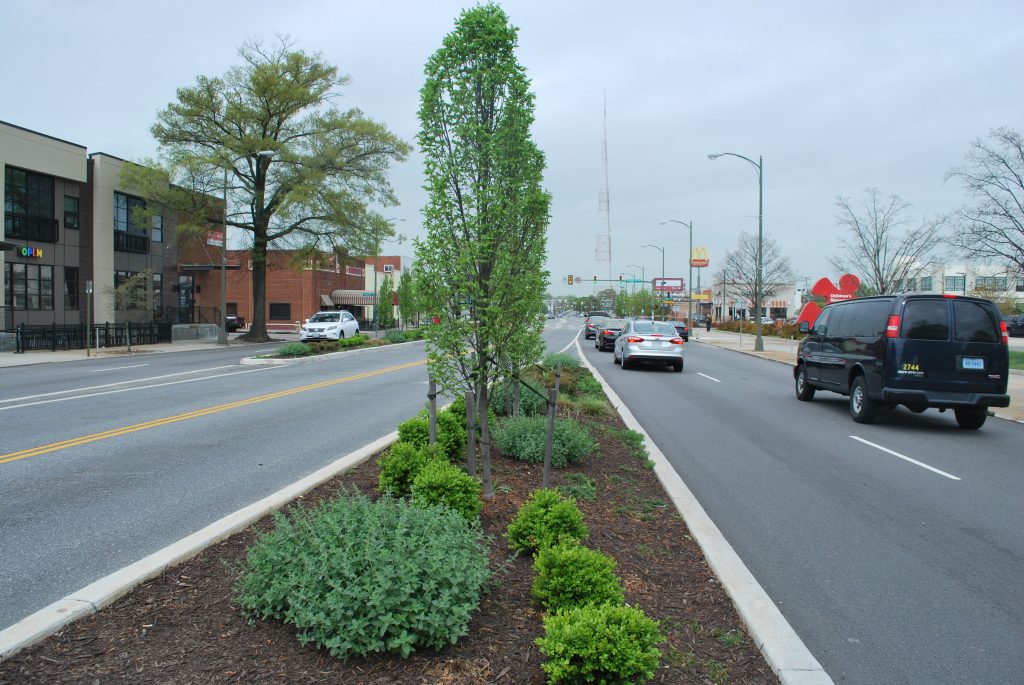GRTC Grows Greener
The passenger platforms for PULSE, the GRTC bus rapid transit system, have been touted for their innovative architecture.

GRTC’s passenger platforms on Broad St. are flanked by greenscapes that feature hardy groundcovers, shrubs and trees. [photo credit: Ashley Mason]
The largest planting is little more than 6 to 10 feet wide. However, the 26 stations are situated along a high-profile corridor between Willow Lawn and Rocketts Landing.
Creating each station’s greenscape was not an easy task, shared Neal Beasley, landscape architect and senior project manager with Timmons Group. Some platforms are in the roadway median, while others are curbside. The western platforms are in urban areas where the station’s greenscape is a focal point. Traveling eastbound, the landscape-design goals shifted, so as not to distract from the suburbs’ natural scenery.
Plant and tree selections were equally challenging.
“The reality is we were installing what was equivalent to parking-lot islands along the roadway of Broad Street, which is heavily traveled,” Beasley said. “While surrounded by pavement, there’s a heat-island effect where the plants experience excessive heat in the concrete planters, unless they have the benefit of shade, most likely coming from buildings.”
In addition, there are power lines, utility vaults and underground utility lines.
Vertical restrictions along the driving lanes safeguard visibility for driver and pedestrian safety. Horizontal restrictions ensure mature tree limbs do not scrape the exterior of passing buses.
The landscapes-in-miniature also must withstand high-volume public access, as well as pollutants from vehicular fossil fuels.
Seasonal changes add other complexities, including summer’s drought and winter’s snow piles with exposure to roadside salt spray.
“It’s a brutal environment for plants,” Beasley said.
Carrie Rose Pace, GRTC director of communications, shared another objective.
“Like the hardscapes, we wanted the stations’ softscapes to blend in naturally with the routes and the neighborhoods,” she said. “It was important for GRTC to use native plants and adaptive species that are hardy and drought tolerant.”
Responsive solutions
Beasley began with low shrubs, perennials and ground covers. The master plant list included 600 Caesar’s Brother irises that produce deep blue flag-like flowers on rigid stems in late spring.
“They’re tough and showy, plus they can handle roadside salt,” Beasley said.
The groundcovers, when totaled, called for a mix of 315 Angelina yellow stonecrops, 320 Bar Harbor junipers and 1,000 Blue Pacific junipers.
In addition, trees with a columnar form were selected to meet the height and width restrictions.
“We know how important trees are to our health and wildlife systems,” Beasley said. “Whenever we plant a tree, we’re doing the right thing. It’s important to include trees wherever we can in urban projects like this one.”
In a nod to permaculture, stormwater was harvested from the platforms’ canopies and routed through a gutter-and-pipe system to self-irrigate the plants. As a secondary benefit, the in-ground system reduces stormwater runoff.
“We also did our own plant-smithing so there is an aesthetic experience from each perspective,” Beasley said. “Whether seeing a flash of color when driving by, seeing a mass of plantings across the street or waiting at the station and seeing a flower of a more delicate species in proximity, you appreciate it all.
“It will take a couple years for the plants to root in, but within three to five years the plan will come to life,” Beasley said.
Rose Pace added, “When we were designing the stations, we wanted a local, unique look that represents the Richmond region. The designers absolutely achieved this goal, and GRTC is pleased with how handsome the stations are. There aren’t any other stations that look like ours.”
This article first published in the Richmond Times-Dispatch in May 2019.